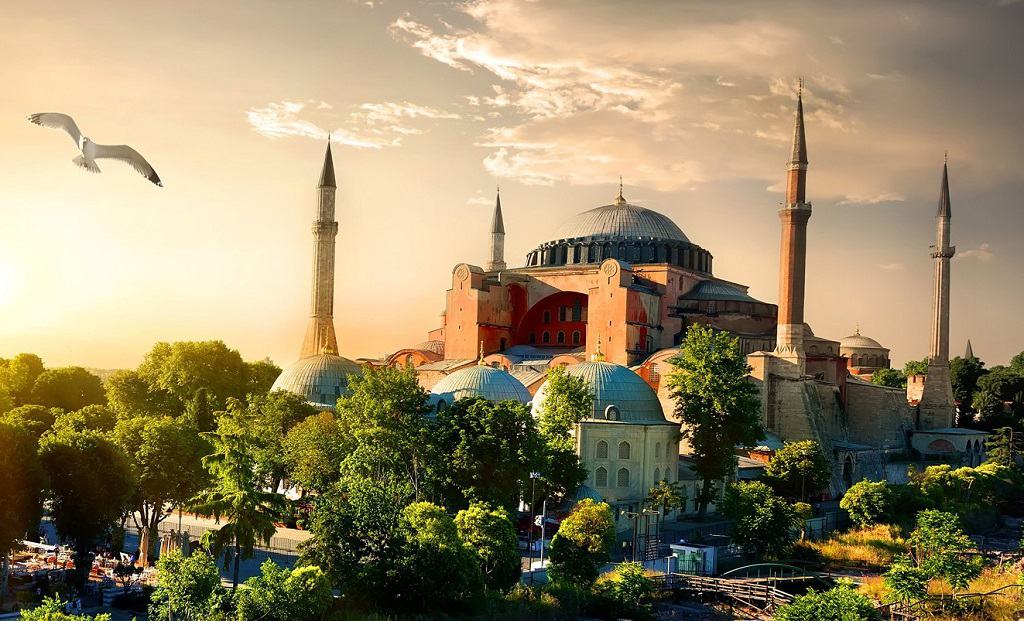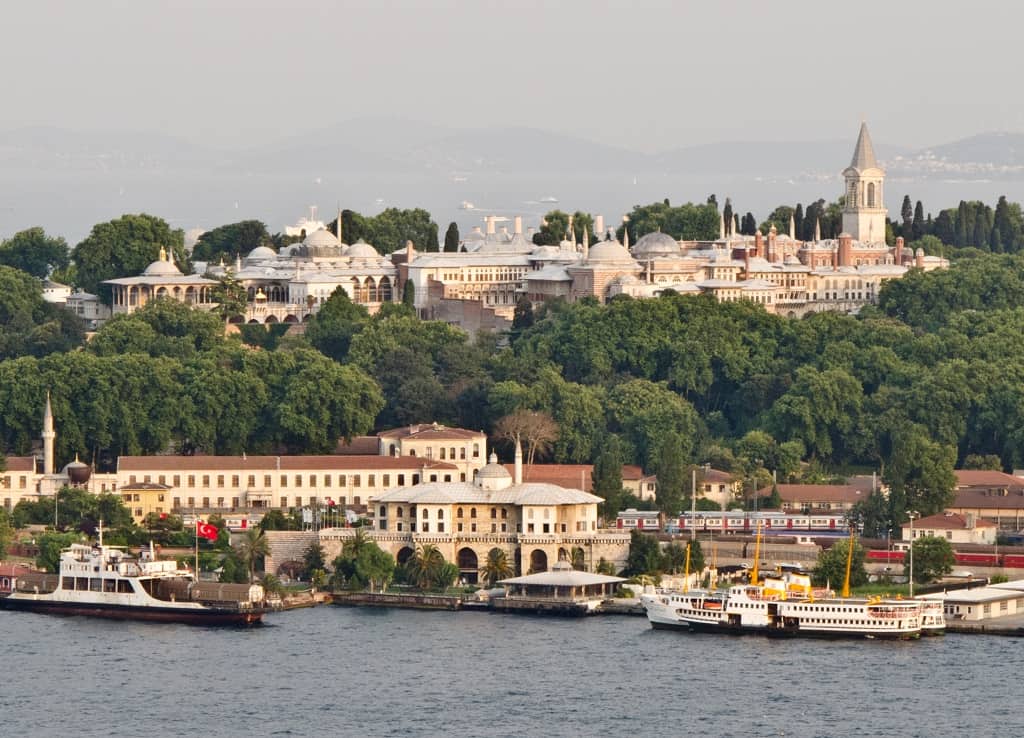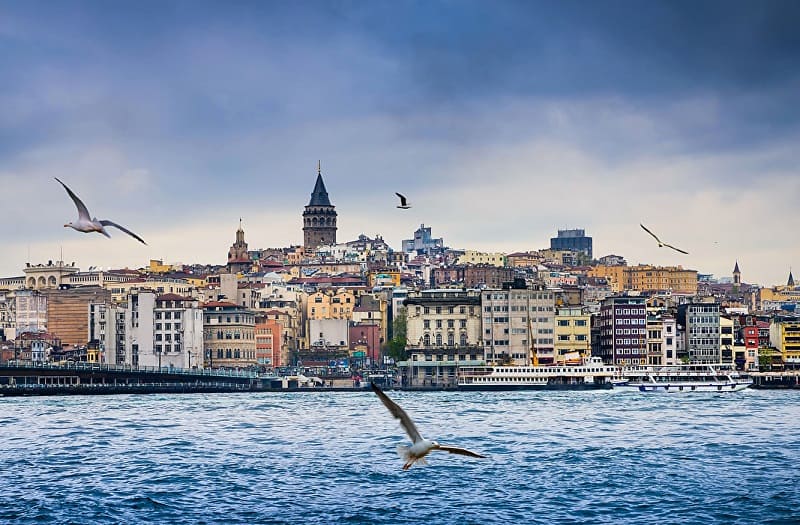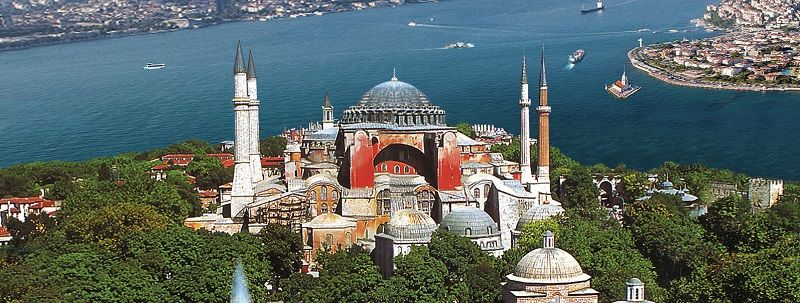Hagia Sophia; Opening Hours, Entrance Fee, How to Get, What to See?
Hagia Sophia (meaning “Holy Wisdom” in Greek) or Ayasofya in Turkish, is the first cathedral of the world and located in Istanbul, the biggest city of Turkey. It is also the first church with a large dome and not in basilical plan. Built in 537 AD, Hagia Sophia has been one of the symbols of Roman Empire, Byzantium, Ottoman Empire and modern Republic of Turkey for 1500 years. Hagia Sophia was an Eastern Orthodox Church and ecumenical patriarch of Constantinople until 1453 and later on the Imperial Mosque in Ottoman Empire. Hagia Sophia is one of the most important masterpieces in the history of architecture and most visited touristic attractions in the world. It is a very special and unique structure in terms of size, magnificence, historical, artistic and cultural value.
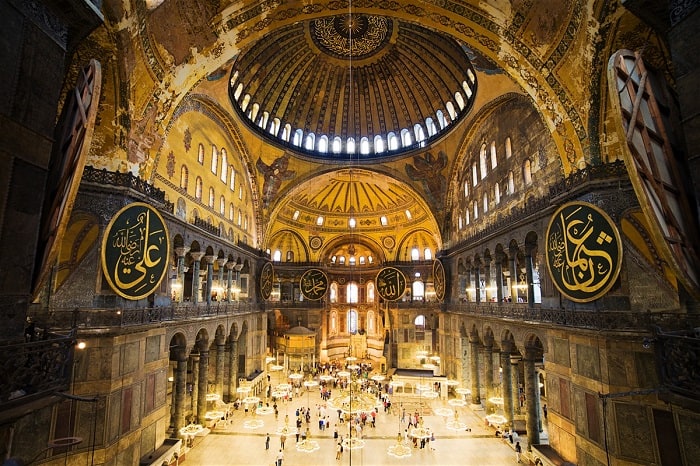
In the 16th and 17th centuries a mihrab, pulpit, two lodges for muezzin and sultan (maksure) were added. Hagia Sophia was transformed into a complex during the Ottoman Period with four minarets, a high school (madrasah), secondary school, fountains, sundials, chamber of trustees etc built outside the building in different periods.
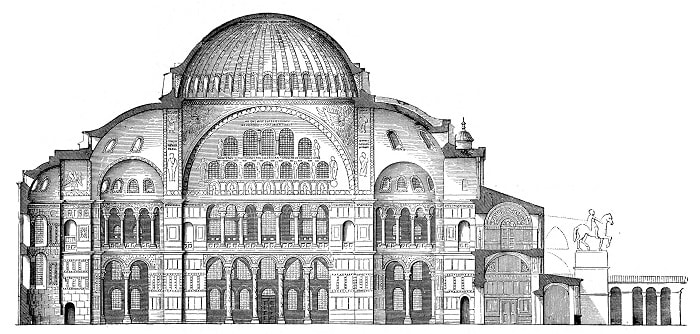
Hagia Sophia was converted into a museum in 1935 upon the order of Mustafa Kemal Atatürk (the founder of modern Turkey) and the decision of the Council of Ministers.
Opening Hours
Since Hagia Sophia was converted into a mosque in 2020, it is open to visitors 24/7 and entrance is free for everyone. However, it is recommended that you do not visit it, especially on Friday afternoons and during all prayer times. You can see prayer times here.
Best time to visit Hagia Sophia
The best days to visit Hagia Sophia are midweek, especially Tuesdays and Wednesdays and in the evening when the crowds are thinner.
Notes; it’s advisable to tour the museum with an official guide for an accurate and in-depth understanding, as well as to bypass the lengthy ticket queues.
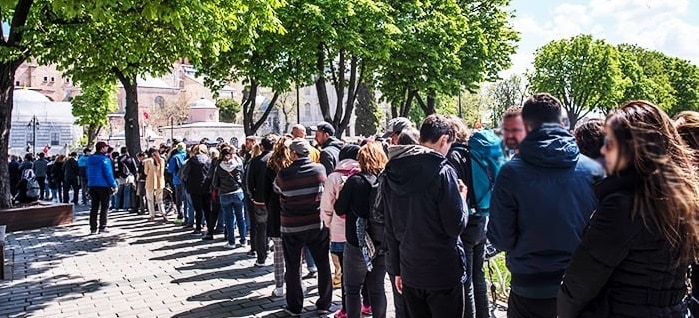
- Hagia Sophia may stay open everyday during spring and summer season according to visitor density.
- It is closed to visitors during the first days of religious holidays; Ramadan and Eid.
Hagia Sophia Entry fee
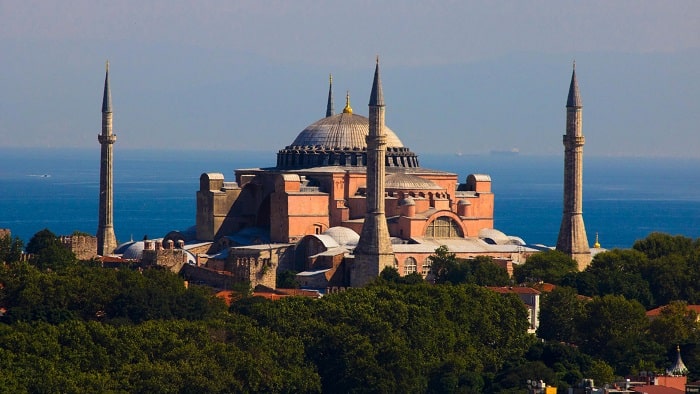
Where is Hagia Sophia And How To Get There?
Address: Hagia Sophia Museum, Sultanahmet Square, Fatih / Istanbul – Turkey
How to get there; Hagia Sophia is located on the historical peninsula of Istanbul and in Sultanahmet district. You can reach Hagia Sophia by the T1 tram line (Gülhane or Sultanahmet stops) or the Marmaray Metro Line (Sirkeci Station). It is 10 minutes from Gülhane, 2 minutes from Sultanahmet and 15 minutes from Sirkeci Station, by walk.
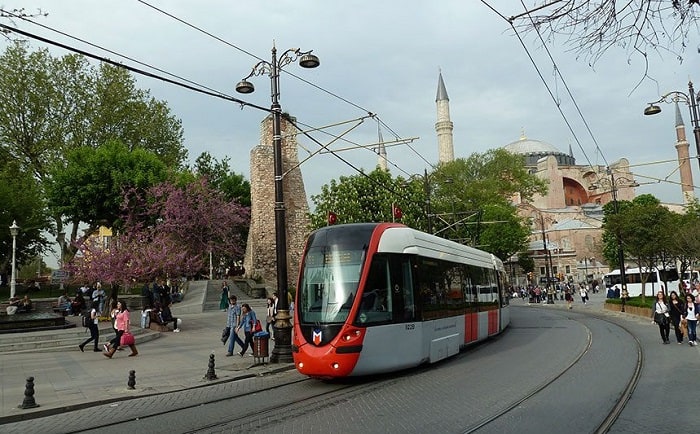
Phone; +90 (212) 522 17 50, +90 (212) 522 09 89
A Brief History of Hagia Sophia
Hagia Sophia, constructed three times on the same site, stands as the largest church built in Constantinople (now Istanbul) by the Eastern Roman Empire. The final iteration, renowned for its grandeur, is the one that exists today.
The historical account of Hagia Sophia’s construction can be refined for clarity and accuracy as follows:
The first incarnation of Hagia Sophia, known as Megale Ekklesia, was constructed in 360 AD under the reign of the Eastern Roman Emperor Constantine. This initial structure, characterized by a wooden roof and a basilical plan, was destroyed during a civil uprising in 404 AD, sparked by conflicts between Empress Eudoksia, the wife of Roman Emperor Arkadios, and Patriarch Ioannes Chrysostomos. While no remnants of this first church survive, bricks marked as ‘Megale Ekklesia’ stored in the museum’s warehouse are believed to be from this original structure. A mosaic depicting Patriarch Chrysostomos can be seen on the northern tympanum wall of the current Hagia Sophia.
The second church, commissioned by Emperor Theodosius II, was rebuilt in 415 AD. This building, known for its basilica plan with five naves, a wooden roof, and a grand entrance, was also destroyed during the Nika Riots, a massive rebellion against Emperor Justinianos on January 13, 532. Some remnants of this structure have endured to the present day, including marble steps, column bases, and reliefs featuring lamb figures symbolizing the apostles, as well as friezes from the building’s monumental gate (propylon).
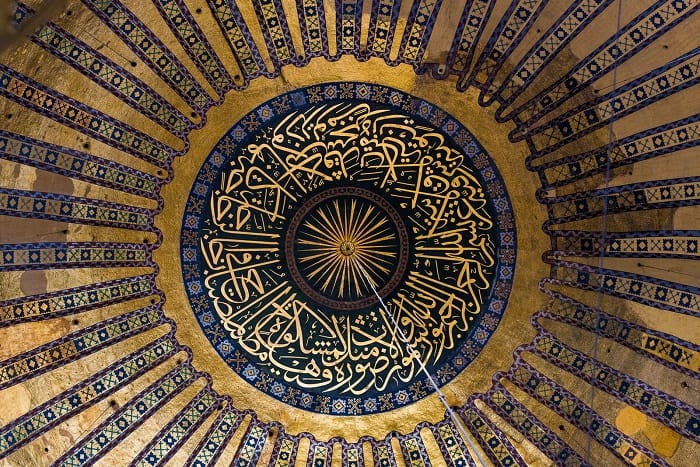
The present Hagia Sophia, known as a significant architectural marvel, was commissioned by Emperor Justinian I. The construction was overseen by two prominent architects of the time, Isidore of Miletus and Anthemius of Tralles. According to the historian Procopius, the construction began on February 23, 532, and remarkably, the edifice was completed within a mere five years, opening on December 27, 537.
Historical records note that upon the inauguration of Hagia Sophia, Emperor Justinian entered the grand structure and is reputed to have exclaimed in awe, “Thank God for giving me the opportunity to create such a place of worship.” He is also said to have declared, “Solomon, I have surpassed you,” in reference to the famed Temple of Solomon in Jerusalem. These statements reflect both his pride in accomplishing such an architectural feat and the religious significance of the building.
Interior Decoration
Emperor Justinian I aspired to make Hagia Sophia a symbol of unparalleled magnificence and splendor. To achieve this, he commanded that the finest architectural elements be gathered from throughout his empire for its construction. The columns and marbles used in Hagia Sophia were sourced from ancient city ruins across Anatolia and Syria, including notable locations like Aspendos, Ephesus, Baalbek, and Tarsus. The structure’s white marbles were procured from the Island of Marmara (Prokonnesos), green porphyries from the island of Euboea, pink marbles from Afyon, and yellow marbles from North Africa.
The marble pieces, notably characterized by their colorful veins, were expertly sliced into symmetrical shapes for the wall coverings, enhancing the interior’s decorative richness. Additionally, green columns from the Temple of Artemis in Ephesus and eight porphyry columns sourced from Egypt were integrated into the naves and under the semi-domes, respectively. Hagia Sophia houses a total of 104 columns, distributed between 40 in the lower gallery and 64 in the upper gallery, each contributing to the grandeur and architectural brilliance of the edifice.
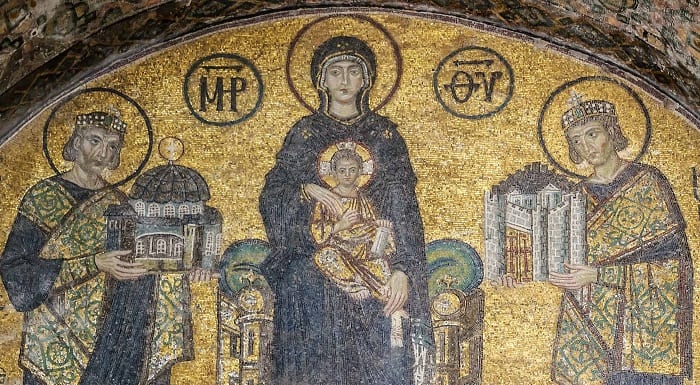
What To See In Hagia Sophia
The Dome
The most important innovation in the architecture of Hagia Sophia was that the dimensions of the structure. It was larger than usual for a church and the size of the dome that dominates the building and its height from the ground.
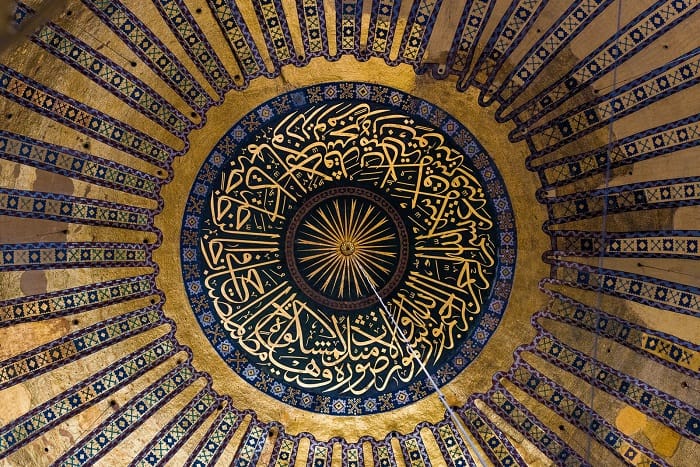
The construction of Hagia Sophia predominantly utilized marble, stone, and brick. To enhance the building’s earthquake resilience, specially crafted light and robust bricks made from the soil of Rhodes were employed in the dome’s construction, aimed at preventing its collapse during seismic events.
Mosaics
Hagia Sophia is renowned for its exquisite mosaics, which were created during various periods and contribute significantly to its aesthetic and historical value. Among these mosaics, the most significant and ancient examples can be found in the narthex area. These early mosaics are particularly notable for their aniconic (non-figurative) designs, a characteristic feature of the early Byzantine period. The intricate details and the artistry of these mosaics reflect the rich cultural and religious history of the edifice.
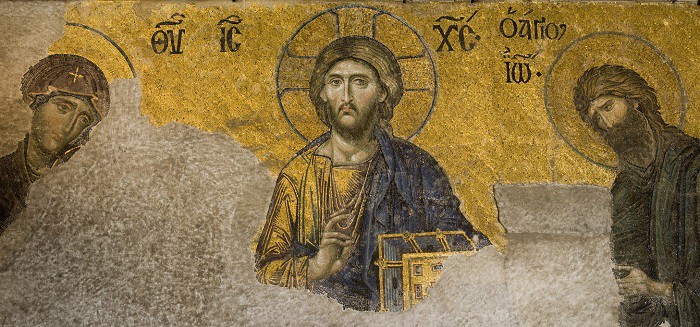
It is widely believed that during the Byzantine era’s period of iconoclasm, which entailed the destruction of icons and other religious imagery, all figurative mosaics within Hagia Sophia were removed. The mosaic situated on the apse ceiling, representing the first figurative mosaic created in Hagia Sophia after the end of this iconoclastic period in 843 AD, marks a significant shift in the Byzantine art and religious policy.
Throughout Hagia Sophia, one can observe various figurative mosaics that were designed in different periods. These mosaics are especially prominent in areas such as the upper gallery, the tympanum wall, the narthex, the vestibule entrance, and the priests’ rooms. The diversity in styles and themes of these mosaics across different parts of the building reflects the rich historical and artistic evolution of Hagia Sophia over the centuries.
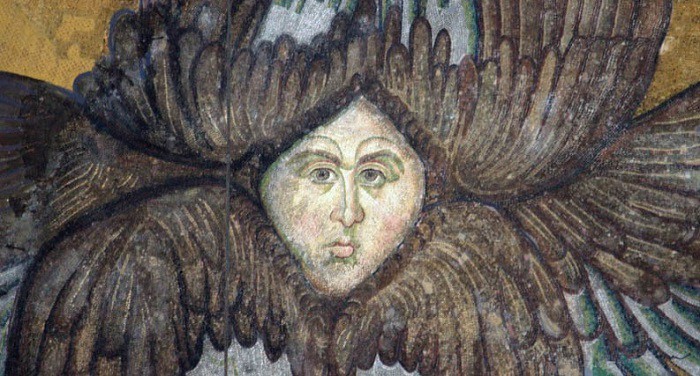
More to See in Hagia Sophia Museum
- The ruins of the second church
- The unique dome and its decorations
- Imperial Door, Orea Porta (Beautiful Door) and mosaics
- Serafim angels
- Sultan’s Lodge (Maksure)
- Pulpit / Muezzin’s Lodge
- Eight Islamic calligraphic panels
- Sweating / Wishing Column
- Upper Galleries and mosaics (closed for a period)
- Basket style Byzantine column headers
- “Deisis” composition showing John the Baptist and the Virgin Mary while praying to
- Grave stone of Enrico Dandolo, Duke of Venice, responsible for the devastating and terrifying attacks on Constantinople
- Heaven and Hell Gates
- Mosaics of Jesus The Pantocrator
- Mosaics depicting Saints Ignatius, Linus and Ignatius Theophoros
- Mosaic showing Jesus consecrating Emperor Constantine IX Monomachus and his wife Zoe
- Two large cubes made of gooseberry (water marble) in Bergama
- The Viking scripture (closed for a period)
- The library built by Sultan Mahmud I in 1739
- Baptistry
- Sultan Tombs
